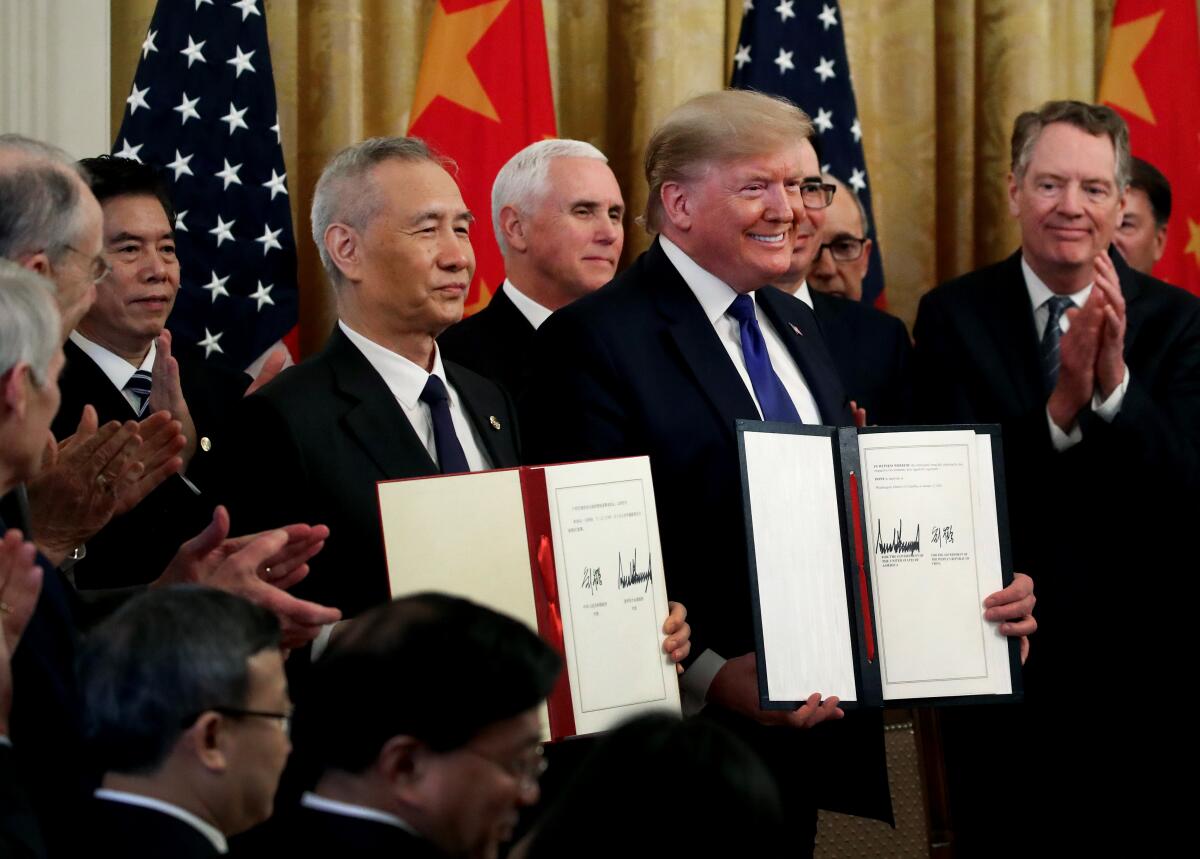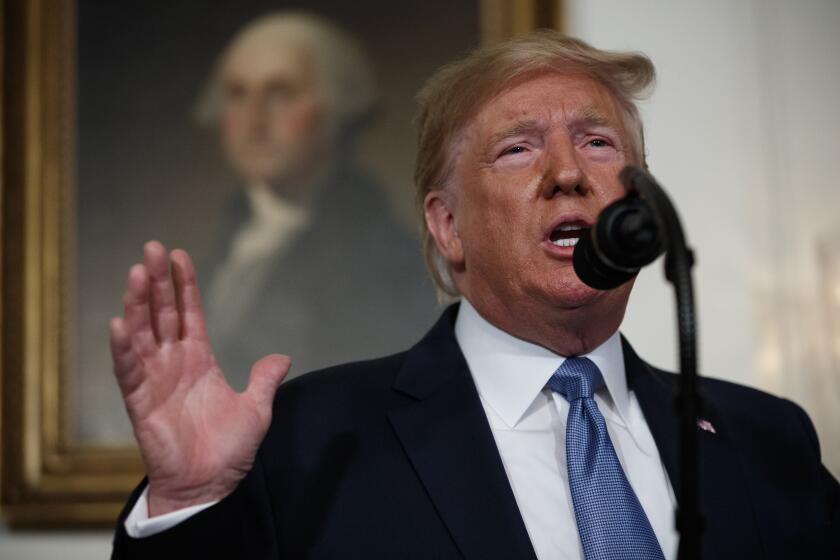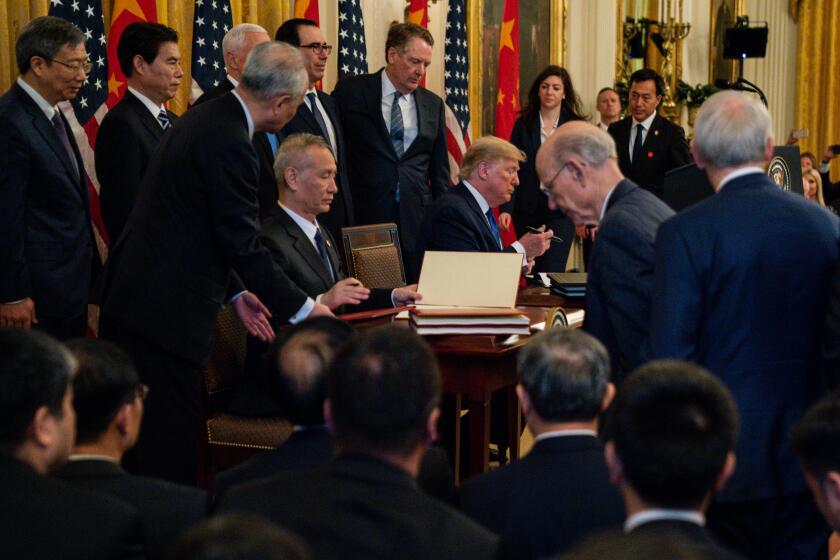Column: Trump’s response to legal defeats shows he’s a paper tiger

A couple of notable events occurred during the month of February in California’s three-year war with the Trump administration over White House efforts to impose retrograde policies on the Golden State and other jurisdictions.
On Feb. 7, word leaked out that the administration had dropped an antitrust investigation of BMW, Ford, Honda and Volkswagen. Those are the four carmakers that had reached an agreement with California largely upholding the state’s strict auto emissions rules.
The threatened antitrust probe was generally viewed as a petulant response to the companies’ decision to buck the administration’s efforts to drastically loosen the rules, but was unnerving to the auto industry nonetheless.
“These trumped-up charges were always a sham,” Gov. Gavin Newsom said after the decision emerged. He called the decision “a victory for anyone who cares about the rule of law and clean air.”
On Feb. 21, the government abruptly dropped its appeal of a November federal injunction requiring that it provide mental health care to immigrant parents and children separated at the border by the administration’s “zero tolerance” policy.
The notice came on the very day that the government was required to submit its appellate brief in the case, in which a federal judge in Los Angeles certified a class estimated at more than 3,500 families entitled to care. Instead, the government notified the U.S. 9th Circuit Court of Appeals that it had determined that an appeal is “no longer warranted.”
California and other states take aim at Trump’s reversal of lightbulb rules, a dopey tea party cause.
Lawyers for the families that had brought the case said the government would have to promptly start providing mental health screening and treatment of the affected families. The Department of Health and Human Services is expected to issue a contract shortly to a healthcare services agency that will manage outreach to the families and oversee whatever care is warranted, according to Amy Lally, a lawyer for the families.
These events underscore something that close observers of the Trump administration — indeed, even of the pre-presidential Donald Trump — have noticed over the years: When confronted with a likely loss in court or political resistance, he often backs down.
That’s an important insight, given the sheer number of administration initiatives that have drawn court challenges or political resistance. Trump will often articulate a policy or threaten a lawsuit as though to test the air, but not follow through.
“When things don’t go their way, they try to quietly let things disappear,” California Atty. Gen. Xavier Becerra told me. “You rarely see a tweet from Donald Trump when he loses.”
As I’ve reported in the past, executive branch agencies have often tried to roll back an existing regulation but failed to lay the administrative groundwork, including developing a factual record justifying the change, needed for their efforts to pass legal muster.
As a result, dozens of rule-makings have been rejected by courts as “arbitrary and capricious,” a phrase that denotes violations of the federal Administrative Procedures Act. The act requires that a change in a regulation must be supported by a record at least as thorough as the one assembled to justify the regulation in the first place. Others have been overturned because an agency didn’t have the legal authority to make or change a rule.
“The agencies are really falling down on that front,” says Bethany A. Davis Noll, litigation director at New York University’s Institute for Policy Integrity. The institute’s database shows that the Trump administration has lost 66 of the 71 cases in which its deregulatory or policy initiatives have been challenged in court.
Appeals are pending in many of those cases, but in 17 of the 66 losses, the agency has backed down, whether by reinstating a rule it tried to overturn, withdrawing a policy proposal, or reaching a settlement with the plaintiffs challenging the rule.
California has been the beneficiary of many of those rulings or settlements, in part because the state is among the most aggressive challengers of Trump policies. The latest tally by Becerra’s office lists 75 lawsuits against the administration that the state has brought or participated in. Most (41) have involved environmental regulations, which have been targets of Trump’s deregulatory policies since his inauguration. But there have also been 13 cases on immigration policy and 10 on healthcare.
Becerra points to cases such as one challenging the Environmental Protection Agency’s attempt to repeal or delay an Obama-era regulation imposing tighter emissions standards on “glider” trucks, which are refurbished freight haulers. After California, 13 other states and a coalition of environmental groups challenged the EPA, the agency, facing the risk of a major loss in court, announced it would enforce the rules after all.
In 2018, California joined New York and Maryland in demanding in court that the EPA stop delaying a rule mandating health and safety training for farmworkers exposed to pesticides. Weeks after the lawsuit was filed, the EPA issued the training mandate.
“Sometimes we’ve been able to get them to back down without filing,” Becerra says.
The most recent case, in which Becerra is co-leader with New York Atty. Gen. Letitia James of a coalition of 16 states challenging Trump’s rollback of energy efficiency standards for lightbulbs, was filed Tuesday in federal court in New York. “They’re trying to backslide every way they can,” Becerra says, “and we keep holding their feet to the fire.”
According to a litigation tracker devised by political scientist Paul Nolette of Marquette University, California is second only to New York in the number of lawsuits against the Trump administration in which it’s been the lead plaintiff, 31 lawsuits to 36.
The area in which Trump has shown the least steadfastness is the one in which he has projected the most rigidity: his trade war. During his term, Trump has threatened tariffs on European cars, Brazilian steel and aluminum and all imports from Mexico.
None of those has actually been imposed. Instead, the threats have been withdrawn, if only conditionally, after parleys with officials from the target countries — or merely agreements for negotiations some time in the future. In those cases, Trump looks tough but doesn’t have to follow through on trade threats that will actually impose costs on American importers and consumers.
President Trump has declared victory in the trade war with China -- but America has paid all the price.
Trump hasn’t always backed away from tariff threats — on Feb. 14, the U.S. said that it would increase the tariff on European-made aircraft to 15% from 10% on March 18 and that it would leave in place 25% duties on Scotch whiskey and French wines.
The policy that has been subjected most often to Trump’s tendency for waffling has been China trade.
At this moment, U.S. tariffs are in effect on about $550 billion in Chinese goods, and retaliatory tariffs have been imposed on about $185 billion of U.S. goods. Since July 2018, when the first U.S. tariffs were imposed, there have been several escalations of trade barriers on each side and about a dozen rounds of truces or talks. In August 2018, the U.S. declared China a “currency manipulator,” then dropped the designation in January 2020.
The result of all this activity was a so-called Phase 1 trade deal signed Jan. 15 that left most of the tariffs in place and failed to resolve most of the genuine issues dividing the two big trading partners.
The agreement called for China to purchase $200 billion over the next two years of American agricultural and manufactured goods, services, crude oil and other energy. But there remains considerable skepticism that China actually can absorb imports on such a scale, or even whether it truly means to. With the coronavirus crisis, which wasn’t evident at the time, now in full cry, those doubts may be heightened.
Trump hasn’t waffled on everything, to be sure. The administration is still standing foursquare behind a lawsuit brought by Texas and 17 other red states aiming to declare the Affordable Care Act unconstitutional, even though many legal experts regard the case’s premise as absurd, and though a successful court battle would eliminate coverage safeguards for people with preexisting medical conditions that Trump says he favors.
The administration is also still pushing for work requirements for Medicaid recipients, even though they’ve been blocked in federal court, cost more than they save, and are known to be useless in promoting job growth.
We’ll say this for President Trump: When he misunderstands something, he misunderstands it more than anyone else in creation.
Nor is Trump always a loser in federal litigation. In recent days, the administration has notched a couple of notable wins in federal court. The San Francisco-based 9th Circuit Court of Appeals on Monday upheld a so-called gag rule issued by the administration, barring federally funded medical clinics from referring women for abortions. The rule had prompted Planned Parenthood to withdraw from federal funding in order to preserve its latitude to offer medical options for patients.
The 7-4 decision may have reflected Trump’s increasing influence over the traditionally liberal appellate circuit through his judicial appointments. Of the seven judges upholding the rule, two were his appointees. The other five were appointed by Republican Presidents George W. Bush or Ronald Reagan; the ruling was written by Judge Sandra Ikuta, an appointee of George W. Bush. All four dissenters were Clinton appointees.
On Wednesday, the White House secured a victory from the New York-based U.S. 2nd Circuit Court of Appeals, which upheld its blockade of federal funding to several states over “sanctuary city” designations. The policy applied to jurisdictions that refused to give immigration officials access to jails or advance notice when an undocumented immigrant was about to be released.
The White House had pursued the case aggressively after the 9th Circuit court and appeals courts in Philadelphia and Chicago had upheld injunctions against the funding actions. The issue may now be destined for the Supreme Court.
But Trump’s image as a president who gets his way through bullying is, at best, exaggerated. Even amid the pitched battle between the federal government and California over auto emissions, the two have worked together on some initiatives.
In January, the California Air Resources Board and the U.S. Environmental Protection Agency reached a joint $22-million settlement with Kohler Co. over allegations that the company installed “defeat devices” on some engines for products such as lawn mowers and leaf blowers in violation of state antipollution laws. California’s share of the settlement was $6 million. The state and federal government have also worked jointly on regulations for emissions from heavy-duty trucks.
But the broader record shows that the best way to deal with Trump’s bluster is to confront it, head on.
More to Read
Inside the business of entertainment
The Wide Shot brings you news, analysis and insights on everything from streaming wars to production — and what it all means for the future.
You may occasionally receive promotional content from the Los Angeles Times.













